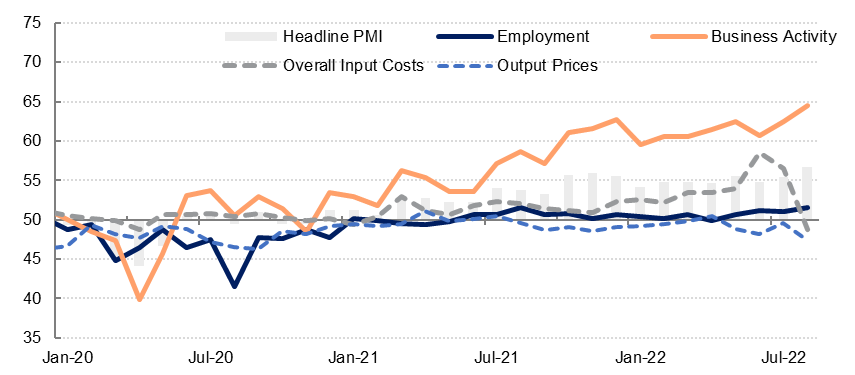
The UAE’s PMI rose to 56.7 in August from 55.4 in July, its highest level in more than two years, underpinned by strong growth in business activity and new work, both of which grew at a faster pace in August relative to July. In the UAE, domestic demand appeared to be the main driver of growth in August, as new export orders increased at the slowest rate since January. Private sector firms increased headcount in August for the fourth consecutive month, and at a slightly faster pace than in July.
Encouragingly, input costs declined in August after rising sharply in the prior two months, with most firms citing lower petrol prices as the reason. Lower costs led to increased purchasing activity and restocking of inventories last month, and also allowed firms to reduce selling prices at the fastest pace since August 2020.
While firms remain optimistic overall about the outlook for the next year, the future output component of the survey declined to a 17-month low in August, as UAE firms fret over the deteriorating global economic backdrop and the rising risks of recession in key markets.
 Source: S&P Global, Emirates NBD Research
Source: S&P Global, Emirates NBD Research
In Saudi Arabia, the headline PMI rose to 57.7 in August from 56.3 in July. As in the UAE, both business activity and new work grew at a faster rate last month, and employment in the kingdom’s private sector increased for the fifth consecutive month. The PMI survey showed that new order growth was strongest in the wholesale & retail sector, although manufacturing, construction and services firms also reported increased new orders.
Input costs for businesses increased again in August but at a slower rate than in June and July, and firms increased their quantity of purchases as well as their stocks of inventory. Selling prices increased only fractionally on average, with the selling price index at the lowest level since February. The survey showed that firms in the wholesale & retail and manufacturing sector reduced charges in August as cost pressures eased.
Saudi private sector firms remained highly optimistic about their expected output over the coming year, relative to their UAE counterparts.
.png) Source: S&P Global, Emirates NBD Research
Source: S&P Global, Emirates NBD Research
Egypt’s headline PMI reading showed a more modest contraction in the private sector in August, as the headline reading rose to 47.6 from 46.4 in July. Nevertheless, headwinds remain as the country navigates the ongoing fallout from the conflict in Ukraine and uncertainty over monetary and exchange rate policy over the coming months. New orders contracted at a slower pace than seen the previous month but continue to decline in August, and new export orders slipped back into negative territory also, having been briefly positive in July.
In terms of price pressures, purchase costs have slowed somewhat as global commodity prices have eased off from the highs seen earlier in the year, while staff costs turned negative even as employment ticked up at the fastest pace since October 2019. Nevertheless, rising input costs remain a challenge for businesses, and some firms also reported difficulties in sourcing raw materials as the global supply chain disruption continued. As a result, some firms reported cutting salaries as they contended with higher prices elsewhere in the business. The slowdown in input cost inflation did however enable firms to slow the rise in output prices, which should ease pressure on Egypt’s headline CPI inflation reading over the coming months.
In this environment, and with a new IMF deal still not finalised, business optimism remained downbeat at the second lowest in the series, and only 9% of respondents expected improved conditions over the next 12 months.